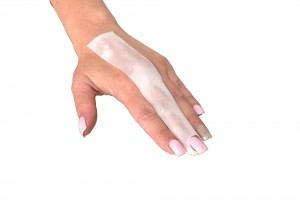So what are our simple suggestions for glowing winter skin?
- Be kind to your skin. Avoid long hot showers and baths. As tempting as they are, the intense heat actually breaks down the skin’s lipid barriers, leading to moisture loss. Overheating at night will have a similar effect. And don’t forget to moisturise your skin all over after a shower, ideally applying to slightly damp skin for optimal absorption.
- Moisturise more. Consider changing to a heavier moisturiser if your skin is feeling tight or dry, or becoming flaky. Heavier creams or ointments will provide better moisturisation than light creams or lotions (such as those in pump packs), which have more added water. You can also look for lotions containing “humectants,” a class of substances (including glycerine, sorbitol and alpha-hydroxy acids) that draw moisture to your skin and bind it.
- Lubricate your lips. Use a hydrating, SPF 50+ lip balm to avoid dry, cracked lips.
- Give your hands a hand. The skin on your hands is thinner and has fewer oil glands than most other parts of the body, so it can dry out more easily especially in cold, dry weather. This can lead to itchiness and cracking of the skin. Remember to moisturise your hands after washing and wear gloves if it’s cold outside.
- Slather on sunscreen. Make sure you still use a sunscreen in winter as winter sun and snow glare can still damage your skin. Deeper penetrating and ageing UVA is present all year round and even penetrates cloud cover. Apply a broad-spectrum sunscreen to your face and hands (if they’re exposed) 20-30 minutes before going outside, and reapply every 2 hours if outside.
UVA light is the same kind of light used in tanning beds or solariums, which are now banned in Australia. We know that UVA light exposure can increase the risk for both photo ageing (wrinkles, pigmentation, dullness) and skin cancer. In 2009, the Archives of Dermatology Journal reported 2 healthy middle-aged women who had been exposed to UV nail lights and subsequently developed skin cancers on the back of their hands1.
A study in JAMA Dermatology2 looked at 17 different light sources from 16 different nail salons and measured UVA exposure for a single visit. It also studied exposure from 5 different hand positions within each device. The results showed that the amount of UVA radiation exposure differed greatly from device to device and also from position to position within the device.
Although the total amount of UVA exposure per visit was low, if you’re having weekly manicures this UVA exposure can soon add up. As few as 8 visits using higher-wattage lamps (which emitted higher UVA) were enough to potentially cause skin damage.
 Shield UV from www.elliona.com
Shield UV from www.elliona.comSo, what’s our advice? If you’re having a gel manicure and exposing your skin to UVA nail lights, apply broad spectrum sunscreen to the back of your hands 30 minutes prior to your appointment, or wear UVA protective fingerless gloves or shields to lower the risks of skin cancer and skin ageing. Alternatively, go for the “old-fashioned” manicure, bring your iPad or a good book and relax back for 30 minutes while your nails dry naturally.
- MacFarlane DF, Alonso CA. Occurrence of nonmelanoma skin cancers on the hands after UV nail light exposure. Arch Dermatol 2009;145:447-9.
- Shipp LR, Warner CA etc al. Further Investigation in the risk of skin cancer associated with the use of UV nail lamps. JAMA Dermatol 2014; 150 (7):775-776
Basically the laser light energy is converted to heat energy in the target and causes controlled damage. Laser treatments usually fall into 3 main categories:
- Vascular laser (targeting haemoglobin) to treat broken capillaries, redness, red birthmarks etc.
- Resurfacing lasers (targeting water) to reduce wrinkles and scars
- Pigment lasers (targeting melanin and other pigments such as in tattoos) for treating brown spots, brown birthmarks, tattoos etc.
Lasers are usually named for the internal substance they contain that gives the laser its specific wavelength. These can be gas (such as in CO2 laser), dye (such as in a pulsed dye vascular laser) or solid (such as the Neodymium-Yttrium-Aluminium-Garnet or Nd-Yag laser).
The operator must assess the appropriate wavelength of laser so that energy is delivered to the target, without damaging surrounding structures. Visit our website to learn more about the different types of laser and what they can be used for.

